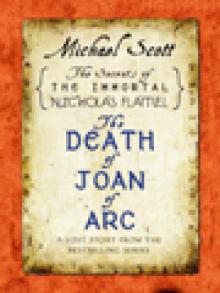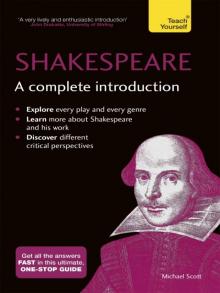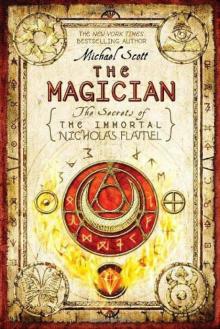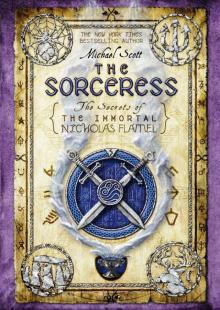- Home
- Michael Scott
Shakespeare- a Complete Introduction Page 3
Shakespeare- a Complete Introduction Read online
Page 3
In The Comedy of Errors, anagnorisis occurs in Act 5, scene 1 when the Abbess, on seeing her long-lost husband, says:
Whoever bound him, I will loose his bonds,
And gain a husband by his liberty.
Speak old Egeon, if thou be’st the man
That hadst a wife once call’d Emilia,
That bore thee at a burden two fair sons?
O, if thou be’st the same Egeon, speak –
And speak unto the same Emilia.
(5.1.340–46)
Egeon replies:
If I dream not, thou art Emilia;
If thou art she, tell me, where is that son
That floated with thee on the fatal raft? (353–5)
So it is that the Antipholus twins are then recognized, as are the two Dromios. This also completes the quest of Antipholus of Syracuse to establish his own identity in a world where identities can be duplicated. Finally, Egeon is pardoned and the assembled company (as well as the audience) is able to laugh at the potentially disastrous errors that have taken place, leaving the two Dromios on stage to exit harmoniously ‘hand in hand, not one before another’.
The play concludes with a family united after adversity, but may possibly leave members of the audience ruminating on what might happen once the twins are again separated from each other. This, however, is a play, not real life. Nothing will happen because the characters are part of a fictional story. From the very beginning of his career Shakespeare innovates, drawing his audience into the narrative of the play.
The structure of the play
This early comic play is nearly perfect in structure – in presenting a problem, an action and a resolution. Some critics (for example Bertrand Evans) have noted that the Abbess is introduced only at the end of the play to resolve the action and does not feature in the errors throughout, which suggests that there might be some slight artistic imperfection in the play’s overall structure. That, however, is at most an academic nicety, and not entirely consistent with the story that Egeon unfolds at the beginning of the play. Given the series of comic coincidences that occur throughout The Comedy of Errors, the appearance of the Abbess at the end is in keeping with the play’s comic ethos, and in production doesn’t detract from the hilarity of the farce or our enjoyment of it. The Comedy of Errors is a neoclassically well-structured and hugely entertaining play.
Some critics may demean the play precisely because it does what it sets out to do. It is written as a farce and does not have the ‘weight’ of the later comedies. Others, such as L. G. Salinger for example, see far too much emotion in it to characterize it simply as a farce. When this play was first performed, the mature romantic comedies were still to come but there is, nevertheless, a foretaste of them here. If we wish to see how Shakespeare’s plays work, The Comedy of Errors actually starts to map out a template on which much of Shakespearean comedy was later to be developed.
‘The fact is that the serious elements are in some danger of going unobserved, while no one is likely to miss the fun, especially in the distorted and jazzed-up versions of the play which are commonly staged.’
Foakes, R. A. (1962: xlix), ‘Introduction’ The Comedy of Errors, The Arden Shakespeare. London: Methuen
In farce, characterization is not developed in detail since the figures are primarily types. The main interest in this play is the characters’ immediate reactions to the chaos being created around them and to which they contribute, often inadvertently. The misunderstandings that produce the hilarity are, at this stage, superficial, and we do not get too close to the predicaments in which the characters find themselves. But in the play there are already pointers towards what will be developed in more sophisticated comic form, and also in tragedy, in the later plays.
As early as Act 1, Scene 2, when the merchant who has helped Antipholus of Syracuse commends him to his ‘own content’, Antipholus replies:
He that commends me to mine own content
Commends me to the thing I cannot get.
I to the world am like a drop of water
That in the ocean seeks another drop,
Who, falling there to find his fellow forth,
(Unseen, inquisitive) confounds himself.
So I, to find a mother and a brother,
In quest of them, unhappy, lose myself.
(1.2.33–40)
This is an early example of soliloquy, whereby a character left alone on the stage is revealing something of himself to the audience, reflecting on his situation. It also points up the issue of ‘identity’ that is crucial here, and is a theme taken up in plays that follow.
We find later in the play that Adriana, the wife of Antipholus of Ephesus, is distraught at her husband’s neglect of her and jealous that he may be looking elsewhere for female company. She laments; but Shakespeare places her dissatisfaction within a comic framework by having her sister Luciana point out the flaws in her argument:
ADRIANA Are my discourses dull? barren my wit?
…
My decayed fair
A sunny look of his would soon repair;
But, too unruly deer, he breaks the pale
And feeds from home; poor I am but his stale.
LUCIANA Self-harming jealousy! fie, beat it hence.
(2.1.92, 99–103)
In later plays, most notably Othello and The Winter’s Tale, Shakespeare explores jealousy at a much deeper level while still exposing errors of perception. The answers the characters give to the errors that occur in The Comedy of Errors result often in what we might call ‘slapstick’ or ‘pantomime violence’, or in claims and rumours that Ephesus is haunted by magic, as Antipholus of Syracuse notes:
They say this town is full of cozenage,
As nimble jugglers that deceive the eye,
Dark-working sorcerers that change the mind,
Soul-killing witches that deform the body,
Disguised cheaters, prating mountebanks,
And many such-like liberties of sin.
(1.2.97–102)
Later, Dr Pinch the conjurer is called upon to exorcize Antipholus of Ephesus in an attempt by Adriana to ‘Establish him in his true sense again’ (4.4.50). Magic, violence, misunderstandings, discontent, loss of identity – all are encompassed but within the recognizable farce of the play. The combination of these elements rarely fails in performance.
Innovation in The Comedy of Errors
The unities of time (a single day), place (a single location) and action (a single plot) in The Comedy of Errors give the play its structure but the comedy is so successful that it allows Shakespeare, even at this early stage in his career, to innovate. In other comedies he moves away from the stranglehold of the unities, giving himself greater freedom and the opportunity to ask of his characters and his narrative the question ‘But what if?’ This allows him to free up the formula for his romantic comedies and in doing so to experiment even further in the tragedies, and with the other plays over whose classification critics continue to argue.
From this early farce, we can discern the formula that Shakespeare is to develop. The action will begin with certain characters embarking on a search in order to find themselves and to achieve peace of mind. That search begins with danger and even the possibility of death. The search for contentment may involve pretending to be from somewhere where you are not and/or being someone you are not. You may, thereby, be displaced from your normal surroundings and alienated in some way or deliberately adopting a persona, or as in the later Twelfth Night it could be all of these. But these journeys relate to the characters themselves being lost, that is, in their very identity, and subsequently found.
The formula or structure involves the sorting out of errors in relationships, certainly with the opposite sex and possibly with the same sex, finding reconciliation in love, as occurs (it would seem) with Antipholus of Ephesus and Adriana or with the reunion of Egeon and his wife the Abbess. These searches lead to a recognition scene, to Aristotelian anagnorisis. S
hakespeare keeps this classical focal point in the construction of many of the comedies and tragedies later in his career. But what happens if that scene is cruelly contrived by one character, as in Measure for Measure, or deliberately frustrated by the dramatist, as in King Lear or in Cymbeline? In The Comedy of Errors Shakespeare lays the foundations for the development of the mature but more flexible structures of the plays to come. The Comedy of Errors is one of the most valuable means by which we can gain an introduction to Shakespeare’s craftsmanship. It is also one of the best plays to watch as an indication of his entertainment value.
3
Critical perspectives 1: Neoclassical and Romantic approaches
Approaches to Shakespeare have varied from age to age since the plays were first performed and published. One of the difficulties for sixteenth- and seventeenth-century critics was the problem that, if Shakespeare flouted neoclassical rules, how is it that he is so good? The Romantics’ concept of ‘the organic nature of art’ provided an answer to the question but as a result they began to venerate him, which led to the rise of ‘bardolatry’.
The fact that Shakespeare did not generally follow the neoclassical rules for dramatic writing is one of two major criticisms that have bedevilled him. The second is the claim that this man from the parochial town of Stratford-upon-Avon, who had received no university education, could not possibly have written the plays. In one sense the two issues – the divergence from neoclassical rules and the authorship question – are grounded in social perceptions, prejudices and intellectual elitism, all of which have been exposed by contemporary criticism.
Spotlight
The allegation that he could not have written the plays is still levelled by some against Shakespeare, despite historical evidence to the contrary and the weight of mainstream literary scholarship that has supported his authorship. It is the subject, for example, of the film Anonymous, which peddles the theory of the Earl of Oxford as the writer of the plays, with little understanding of how the myth began or of how impossible the claim is.
If you read, for example, James Shapiro’s Contested Will or Michael Wood’s In Search of Shakespeare or Jonathan Bate’s The Genius of Shakespeare, you will see that the authorship question has surfaced many times since Shakespeare’s death but that it was based often on misleading or fraudulent evidence. Michael Wood discusses the quality of Shakespeare’s grammar school education in Stratford and provides a useful account of the influence of his family, especially Mary Arden his mother, and his general upbringing, on the development of his imagination.
The seventeenth century
From Robert Greene’s 1592 ‘upstart Crow’ complaint onwards, Shakespeare has often been viewed with some suspicion – even, at times, hostility. How could this non-university-educated newcomer to the literary and theatrical scene be so good? Plays in English were not considered ‘literary works’ until Ben Jonson in 1616 published a folio edition of his own plays, calling them Works. In Shakespeare’s own day, some of his poetry – surprisingly not the Sonnets – was highly successful and well regarded, but the fact remains that he was neither aristocratic nor highly educated. Even Ben Jonson, while admiring his unique, timeless talent, quipped, perhaps ironically, that Shakespeare had ‘small Latin and less Greek’. But, as modern historians have noted, such was the educational system and the standard of the Elizabethan grammar schools that a boy on completing his school education may have been as proficient in Latin as Classics graduates are today. Ben Jonson was not university educated either but he was an exceedingly good classical scholar, so the description ‘small’ has to be put into perspective.
Throughout the seventeenth century, Shakespeare was considered, not only by Ben Jonson but also by later poets such as John Milton (1608–74) and John Dryden (1631–1700), to have been a ‘natural genius’. But do natural geniuses actually exist? Perhaps it is no small wonder, given the breadth of material in the plays, that claims – sometimes based on fraudulent evidence – were made that Shakespeare could not have written them but was merely a front man for an intellectual or aristocratic writer such as Francis Bacon or the Earl of Oxford who wished to remain anonymous. None of this squares, however, with the facts as we have them or the contemporary evidence concerning Shakespeare’s authorship, although later in his career he did collaborate with younger dramatists. The way in which he has been regarded, nonetheless, and the reputation he has acquired over the last four centuries, help shape the way we now approach him.
Spotlight
Milton saw Shakespeare as the supreme English poet but both he and Dryden still had difficulty with his apparent failure to obey the neoclassical rules; they blamed the ‘fury of fancy’ for transporting Shakespeare beyond the bounds of judgement. Antony and Cleopatra, for example, darted from city to city and country to country over several years and contained multiple plots and subplots. This kind of structure went against what was regarded as the disciplines of the art form. Dryden’s own play All for Love (1678), a version of the Antony and Cleopatra story, is in the neoclassical disciplined style, and is occasionally produced on the modern stage in repertory with Antony and Cleopatra. It is a good play but it lacks the breadth of imagination and the theatrical presence of Shakespeare’s masterpiece.
As early as 1681, Nahum Tate regarded Shakespeare’s King Lear as ‘a house of unorganized treasures’, and he rewrote the ending in order to allow Cordelia to fall in love with Edgar and let Lear survive. Tate’s version commanded the stage for the next 150 years. In a more seriously critical vein, in 1697 Thomas Rymer had declared Othello to be a ‘bloody farce, without salt or savour’. Shakespeare’s tragedy did not harmonize with the taste of the age or its literary sensibilities.
The eighteenth century
The late seventeenth-century criticism of Shakespeare continued into the eighteenth century. In France, Voltaire declared Shakespeare to be an ‘English buffoon’, describing Hamlet in 1748 as ‘a vulgar and barbarous drama, which would not be tolerated by the vilest populace of France or Italy’. His choice of the phrase ‘vilest populace’ is of interest to us, especially when we recall the location of the Globe theatre in the suburbs, in what we might now call a red-light district just beyond the boundaries of the city of London.
Shakespeare developed his theatre for all, but in the late seventeenth century and into the eighteenth literary intellectuals regarded Ben Jonson as the purer craftsman. Nonetheless, it was Shakespeare whose reputation grew in spite of his apparent failure to follow neoclassical rules.
The influential scholar Samuel Johnson (1709–84), in his Preface to Shakespeare, rejected the concept of the Unities as an appropriate measure of quality for drama. He saw Shakespeare as depicting ‘life’ and advised that we should consider most of the plays as ‘tragic comedies’. Johnson was, however, critical of some of Shakespeare’s dramatic poetry: he wished to expunge the famous lines in Macbeth ‘Here lies Duncan, his silver skin laced with his golden blood’ with ‘an universal blot’. He also expressed great difficulty with the harrowing final scene of King Lear.
‘Shakespeare’s plays are not in the rigorous or critical sense either tragedies or comedies, but compositions of a distinct kind; exhibiting the real state of sublunary nature, which partakes of good and evil, joy and sorrow, mingled with endless variety of proportion and innumerable modes of combination; and expressing the course of the world, in which the loss of one is the gain of another; in which at the same time, the reveller is hasting to his wine, and the mourner burying his friend.’
Johnson, Dr S. (1765). See Powell, R. [1980: 141], Shakespeare and the Critics Debate. Basingstoke: Macmillan
Key idea
Dr Johnson’s perspective is that Shakespeare does not adhere to the Unities because he has imagination to portray a common humanity, which is not modified by the constraints of time and place.
In the latter half of the eighteenth century Shakespeare was regarded as being able to deal with generalized passions. If you want to
know about jealousy, refer to Othello; if you want to know about young love, refer to Romeo and Juliet; for mature love, see Antony and Cleopatra; for debilitating ambition, see Macbeth; for procrastination, see Hamlet, and so forth. Shakespeare’s genius is thereby considered to lie in the portrayal of a human nature to be found in young lovers and ageing monarchs. His characters are types, displaying human passions.
‘…he was the man who of all Modern, and perhaps Ancient poets, had the largest and most comprehensive soul. All the Images of Nature were still present to him.’
John Dryden in Powell (1980: 140–41)
Nevertheless, as we have suggested, Samuel Johnson is still critical of the dramatist. There is little moral purpose behind the plays; the plots are loosely constructed and even though the Unities are rejected there is no sense of time or place – no clear geographical location whether the setting be Rome, Egypt or Venice. But even more problematic for Samuel Johnson and eighteenth-century Augustan cultural attitudes is the fact that Shakespeare is seen to be deficient in language and decorum, having a laboured narration. In language, Shakespeare’s use of the pun, for example, irritated Johnson as being tedious. It was, he claimed, Shakespeare’s ‘fatal Cleopatra’. This is indicative, perhaps, of what Johnson regarded as a general deficiency in gentility and the protracted narrative scope of some of the plays.

 The Warlock
The Warlock The Necromancer
The Necromancer Tom Cringle's Log
Tom Cringle's Log Delphi
Delphi The Magician
The Magician La mort de Jeanne d'Arc (trad. privee)
La mort de Jeanne d'Arc (trad. privee) Magic and Myth
Magic and Myth The Death of Joan of Arc
The Death of Joan of Arc Saint Patrick
Saint Patrick Aoife and Scathach, Shadow Twins
Aoife and Scathach, Shadow Twins Machiavelli
Machiavelli The Ballad of Black Hawk and Billy the Kid
The Ballad of Black Hawk and Billy the Kid The Sorceress
The Sorceress Nicholas and the Krampus
Nicholas and the Krampus The King of the Birds
The King of the Birds Nicholas Flamel 1 - The Alchemyst sotinf-1
Nicholas Flamel 1 - The Alchemyst sotinf-1 Shakespeare- a Complete Introduction
Shakespeare- a Complete Introduction 06 The Enchantress
06 The Enchantress 05 The Warlock
05 The Warlock The Nameless City
The Nameless City The Necromancer sotinf-4
The Necromancer sotinf-4 Mirror Image
Mirror Image Nicholas Flamel 2 - The Magician sotinf-2
Nicholas Flamel 2 - The Magician sotinf-2 The Sorceress sotinf-3
The Sorceress sotinf-3